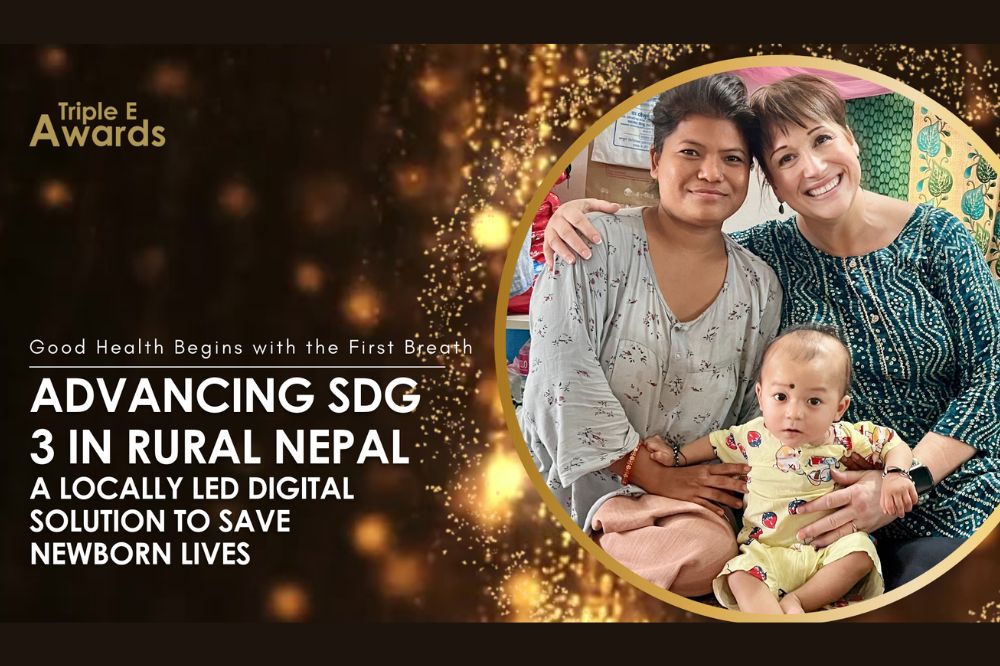
Closing the Gaps in Neonatal Care
In the Lumbini Province of rural Nepal, newborn mortality remains unacceptably high, reaching 30 deaths per 1,000 live births (Rai, et al. 2025), compared to 2.3 per 1,000 in Australia. Behind these numbers are deep-rooted inequities: limited access to skilled birth attendants, scarce training opportunities, and fragile health infrastructure. For many newborns, the critical moments after birth determine survival - and too often, the care needed isn’t available.
One of the leading contributors to preventable neonatal deaths in these settings is birth asphyxia (Apio, et al. 2025), when a newborn fails to breathe immediately after birth. A simple, timely resuscitation response can save a life. In response, the American Academy of Pediatrics and global health partners developed Helping Babies Breathe (HBB), a structured, evidence-based training program that teaches basic newborn resuscitation skills to birth attendants working in low-resource settings. HBB has been shown to reduce early neonatal deaths by up to 47% when effectively implemented (Agudelo-Pérez, et al. 2022).
However, even after training, skill retention deteriorates rapidly without reinforcement, particularly in under-resourced and isolated environments. This project responds to that challenge (Kain, et al. 2023).
It reflects Griffith University’s commitment to the Third Mission of higher education, applying academic knowledge through community engagement to solve problems. Working alongside local healthcare providers and non-government organisations (NGOs), the university is contributing to a practical, scalable solution to improve newborn survival in some of the most underserved communities in the world. This initiative also exemplifies Griffith University’s leadership in delivering impactful Third Mission activities, demonstrating how universities can translate research and innovation into meaningful social change at both local and global levels, recognition that was affirmed when the project received the Triple E SDG Impact Award (Asia-Pacific) for its contribution to reducing neonatal mortality.
From Face-to-face to On-demand Learning
Even the most effective training programs are limited if knowledge and skills aren’t maintained over time. In many low-income health settings, especially where staffing is stretched and support systems are limited, regular in-person refresher training is simply not feasible. Without reinforcement, resuscitation skills decline, often within weeks following training, and the initial investment in training loses its impact.
Recognising this challenge, and building on the original version developed in Uganda, our team adapted a mobile app – HBB Prompt (Chan, et al. 2023) - to complement the HBB training program. The tool is designed not to replace face-to-face instruction, but to bridge the learning gaps that occur after formal training ends.
Using brief, scenario-based learning modules, the app enables healthcare workers to practise and revise essential newborn resuscitation steps on their own time, in their own language, and without needing internet access. It supports a model of continuous, embedded learning, aligned with how health workers in low-income settings actually live and work. By reinforcing core skills in a flexible and locally relevant way, the tool strengthens the long-term effectiveness of HBB and supports safer outcomes for newborns.
Co-designing with Communities
From the outset, this initiative has been shaped by those who are closest to the problem: the healthcare providers working in resource-limited settings. The adaptation of the digital tool was guided by genuine partnership with community-based stakeholders, including frontline healthcare workers, local NGOs, and public health authorities in Nepal, alongside our technical collaborators in Uganda. These partnerships ensured the tool was not only clinically sound, but also culturally responsive and practically usable in everyday clinical settings.
Initial pilot work took place in Nepalgunj, a densely populated but under-resourced city near the Indian border in western Nepal. The area serves as a referral centre for surrounding rural districts and is representative of the conditions faced by many peripheral health facilities across the country with high birth volumes, workforce shortages, and limited access to ongoing training.
Feedback from this early phase showed strong provider engagement and measurable improvement in knowledge retention related to newborn resuscitation. These findings, though preliminary, are encouraging and are now guiding further refinement and localisation of the tool. Continued testing and collaborative input will be essential to ensure the intervention remains relevant, adaptable, and sustainable as it moves toward broader implementation.
A Model for the Third Mission in Action
The role of universities extends beyond research output and academic instruction. Increasingly, they are called to act as catalysts for innovation in practice, working alongside communities to co-design solutions that respond to complex social challenges. This project exemplifies that commitment to engagement, bringing together academic researchers, information technology developers, and public health practitioners in a shared effort to improve newborn survival in low-resource settings, building upon clear and concrete needs of the communities.
At Griffith University, the work is embedded within our Sustainability Strategy 2023–2030 and contributes directly to the United Nations Sustainable Development Goal (SDG) 3: Good Health and Well-being. More specifically, it supports SDG Target 3.2, which aims to end preventable deaths of newborns and children under five years of age, with all countries striving to reduce neonatal mortality to at least as low as 12 per 1,000 live births by 2030.
By engaging in this kind of practical, community-led initiative, the university fulfils its Third Mission, not only generating knowledge but ensuring that it is translated into tangible improvements for health systems and the people they serve by working in partnership with non-profit organisations and local health providers to co-design solutions. In doing so, Griffith ensures that new knowledge delivers both immediate benefits, such as improved resuscitation skills and newborn survival, and lasting impacts through strengthened health systems and sustained community capacity.
What’s Next: Scaling, Testing, Sustaining
The next phase of this work involves expanding implementation into more remote and impoverished districts of Nepal’s Lumbini Province, further from the regional hospital hub, where neonatal mortality rates are often even higher and access to refresher training is limited. Simultaneously, we are continuing collaboration in Uganda, where the first version of the digital tool was developed and used in early field testing. Discussions are also underway with potential partners in other low- and middle-income countries across Asia and Africa to extend the impact of the intervention across similar settings.
To support broader uptake, a multi-site clinical study is planned to evaluate the tool’s effect on healthcare provider performance, resuscitation skill retention, and neonatal outcomes, particularly in reducing early neonatal mortality. Further development work is also required, including adaptation for iOS platforms, user interface enhancements, and the integration of gamified learning features to promote engagement and long-term use. These are essential steps to ensure the tool remains responsive to user needs and scalable across different health systems.
Like many community-based innovations, the long-term viability of the project depends on sustainable investment. We are actively seeking grant funding and philanthropic partnerships to support continued development, evaluation, and integration into national newborn care strategies.
Summary
This project demonstrates how universities can move beyond knowledge generation to meaningful, practice-based engagement with external partners. By supporting a locally-led, evidence-informed intervention that strengthens clinical capacity in low-resource health systems, Griffith University is ensuring its Third Mission activities have lasting impact. The initiative is grounded in respectful collaboration, shaped by community priorities, and focused on sustainable, scalable change. At its core, it is about enabling health workers to provide safer, more effective care and giving more newborns the chance not only to survive, but to thrive.
Agudelo-Pérez, S., Cifuentes-Serrano, A., Ávila-Celis, P., & Oliveros, H. (2022). Effect of the Helping Babies Breathe Program on Newborn Outcomes: Systematic Review and Meta-Analysis. Medicina (Kaunas, Lithuania), 58(11), 1567. https://doi.org/10.3390/medicina58111567
Apio, G., Mbalinda, S. N., Alunyo, J. P., Okibure, A., Makoko, B. T., McVoy, M., & Ayebare, E. (2025). Birth asphyxia outcomes and associated factors among newborns admitted to a tertiary hospital in Eastern Uganda: A prospective cohort study. BMC Pregnancy and Childbirth, 25(1), 487. https://doi.org/10.1186/s12884-025-07603-2
Chan, N. H.-M., Merali, H. S., Mistry, N., Kealey, R., Campbell, D. M., Morris, S. K., & Data, S. (2023). Utilization of a novel mobile application, “HBB Prompt”, to reduce Helping Babies Breathe skills decay. PLOS Global Public Health, 3(5), e0000705.
Kain, V. J., Dhungana, R., Basnet, B., Basnet, L. B., Budhathoki, S. S., Fatth, W., & Sherpa, A. J. (2024). Stakeholders' Perspectives on the "Helping Babies Breathe" Program Situation in Nepal Following the COVID-19 Pandemic. The Journal of perinatal & neonatal nursing, 38(2), 221–220. https://doi.org/10.1097/JPN.0000000000000778
Rai, P., Ackerman, I. N., O'Connor, D. A., Dangal, G., & Buchbinder, R. (2025). Burden of Maternal and Neonatal Disorders in Nepal from 1990 to 2019; Analysis of Data from Global Burden of Disease Study: An Observational Study. JNMA; Journal of the Nepal Medical Association, 63(283), 134–143. https://doi.org/10.31729/jnma.8916

.
Images courtesy of the author.